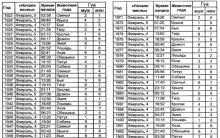Biological membranes- the general name for functionally active surface structures that bound cells (cellular or plasma membranes) and intracellular organelles (membranes of mitochondria, nuclei, lysosomes, endoplasmic reticulum, etc.). They contain lipids, proteins, heterogeneous molecules (glycoproteins, glycolipids) and, depending on the function performed, numerous minor components: coenzymes, nucleic acids, antioxidants, carotenoids, inorganic ions, etc.
The coordinated functioning of membrane systems - receptors, enzymes, transport mechanisms - helps maintain cell homeostasis and at the same time quickly respond to changes in the external environment.
TO basic functions of biological membranes can be attributed:
· separation of the cell from the environment and the formation of intracellular compartments (compartments);
· control and regulation of the transport of a huge variety of substances through membranes;
· participation in ensuring intercellular interactions, transmitting signals into the cell;
· conversion of the energy of food organic substances into the energy of chemical bonds of ATP molecules.
The molecular organization of the plasma (cellular) membrane is approximately the same in all cells: it consists of two layers of lipid molecules with many specific proteins included in it. Some membrane proteins have enzymatic activity, while others bind nutrients from the environment and transport them into the cell across membranes. Membrane proteins are distinguished by the nature of their connection with membrane structures. Some proteins called external or peripheral , are loosely bound to the surface of the membrane, others, called internal or integral , immersed inside the membrane. Peripheral proteins are easily extracted, while integral proteins can only be isolated using detergents or organic solvents. In Fig. Figure 4 shows the structure of the plasma membrane.
The outer, or plasma, membranes of many cells, as well as the membranes of intracellular organelles, for example, mitochondria, chloroplasts, were isolated in free form and their molecular composition was studied. All membranes contain polar lipids in quantities ranging from 20 to 80% of their mass, depending on the type of membrane; the rest is mainly proteins. Thus, in the plasma membranes of animal cells, the amount of proteins and lipids, as a rule, is approximately the same; the inner mitochondrial membrane contains about 80% proteins and only 20% lipids, while the myelin membranes of brain cells, on the contrary, contain about 80% lipids and only 20% proteins.
Rice. 4. Structure of the plasma membrane
The lipid part of the membrane is a mixture of various types of polar lipids. Polar lipids, which include phosphoglycerolipids, sphingolipids, and glycolipids, are not stored in fat cells, but are integrated into cell membranes, and in strictly defined proportions.
All polar lipids in membranes are constantly renewed during the metabolic process; under normal conditions, a dynamic stationary state is established in the cell, in which the rate of lipid synthesis is equal to the rate of their decay.
The membranes of animal cells contain mainly phosphoglycerolipids and, to a lesser extent, sphingolipids; triacylglycerols are found only in trace amounts. Some membranes of animal cells, especially the outer plasma membrane, contain significant amounts of cholesterol and its esters (Fig. 5).

Fig.5. Membrane lipids
Currently, the generally accepted model of membrane structure is the fluid mosaic model, proposed in 1972 by S. Singer and J. Nicholson.
According to it, proteins can be likened to icebergs floating in a lipid sea. As mentioned above, there are 2 types of membrane proteins: integral and peripheral. Integral proteins penetrate the membrane right through, they are amphipathic molecules. Peripheral proteins do not penetrate the membrane and are less tightly bound to it. The main continuous part of the membrane, that is, its matrix, is the polar lipid bilayer. At normal cell temperatures, the matrix is in a liquid state, which is ensured by a certain ratio between saturated and unsaturated fatty acids in the hydrophobic tails of polar lipids.
The liquid-mosaic model also assumes that on the surface of integral proteins located in the membrane there are R-groups of amino acid residues (mainly hydrophobic groups, due to which the proteins seem to “dissolve” in the central hydrophobic part of the bilayer). At the same time, on the surface of peripheral, or external proteins, there are mainly hydrophilic R-groups, which are attracted to the hydrophilic charged polar heads of lipids due to electrostatic forces. Integral proteins, which include enzymes and transport proteins, are active only if they are located inside the hydrophobic part of the bilayer, where they acquire the spatial configuration necessary for the manifestation of activity (Fig. 6). It should be emphasized once again that covalent bonds are not formed either between the molecules in the bilayer or between the proteins and lipids of the bilayer.

Fig.6. Membrane proteins
Membrane proteins can move freely in the lateral plane. Peripheral proteins literally float on the surface of the bilayer “sea,” while integral proteins, like icebergs, are almost completely immersed in the hydrocarbon layer.
For the most part, membranes are asymmetrical, that is, they have unequal sides. This asymmetry is manifested in the following:
· firstly, that the inner and outer sides of the plasma membranes of bacterial and animal cells differ in the composition of polar lipids. For example, the inner lipid layer of human red blood cell membranes contains mainly phosphatidylethanolamine and phosphatidylserine, and the outer layer contains phosphatidylcholine and sphingomyelin.
Secondly, some transport systems in membranes act only in one direction. For example, in the membranes of erythrocytes there is a transport system (“pump”) that pumps Na + ions from the cell into the environment, and K + ions into the cell due to the energy released during ATP hydrolysis.
· thirdly, the outer surface of the plasma membrane contains a very large number of oligosaccharide groups, which are glycolipid heads and oligosaccharide side chains of glycoproteins, while on the inner surface of the plasma membrane there are practically no oligosaccharide groups.
The asymmetry of biological membranes is maintained due to the fact that the transfer of individual phospholipid molecules from one side of the lipid bilayer to the other is very difficult for energy reasons. A polar lipid molecule is able to move freely on its side of the bilayer, but is limited in its ability to jump to the other side.
Lipid mobility depends on the relative content and type of unsaturated fatty acids present. The hydrocarbon nature of the fatty acid chains imparts to the membrane properties of fluidity and mobility. In the presence of cis-unsaturated fatty acids, the cohesion forces between chains are weaker than in the case of saturated fatty acids alone, and lipids remain highly mobile even at low temperatures.
On the outside of the membranes there are specific recognition regions, the function of which is to recognize certain molecular signals. For example, it is through the membrane that some bacteria perceive slight changes in the concentration of a nutrient, which stimulates their movement towards the food source; this phenomenon is called chemotaxis.
The membranes of various cells and intracellular organelles have a certain specificity due to their structure, chemical composition and functions. The following main groups of membranes in eukaryotic organisms are distinguished:
plasma membrane (outer cell membrane, plasmalemma),
· nuclear membrane,
endoplasmic reticulum,
membranes of the Golgi apparatus, mitochondria, chloroplasts, myelin sheaths,
excitable membranes.
In prokaryotic organisms, in addition to the plasma membrane, there are intracytoplasmic membrane formations; in heterotrophic prokaryotes they are called mesosomes. The latter are formed by invagination of the outer cell membrane and in some cases retain contact with it.
Red blood cell membrane consists of proteins (50%), lipids (40%) and carbohydrates (10%). The bulk of carbohydrates (93%) are associated with proteins, the rest with lipids. In the membrane, lipids are arranged asymmetrically, in contrast to the symmetrical arrangement in micelles. For example, cephalin is found predominantly in the inner lipid layer. This asymmetry is apparently maintained due to the transverse movement of phospholipids in the membrane, carried out with the help of membrane proteins and due to metabolic energy. The inner layer of the erythrocyte membrane contains mainly sphingomyelin, phosphatidylethanolamine, phosphatidylserine, and the outer layer contains phosphatidylcholine. The red blood cell membrane contains an integral glycoprotein glycophorin, consisting of 131 amino acid residues and penetrating the membrane, and the so-called band 3 protein, consisting of 900 amino acid residues. The carbohydrate components of glycophorin perform a receptor function for influenza viruses, phytohemagglutinins, and a number of hormones. Another integral protein was found in the erythrocyte membrane, containing few carbohydrates and penetrating the membrane. He is called tunnel protein(component a), since it is believed to form a channel for anions. A peripheral protein associated with the inner side of the erythrocyte membrane is spectrin.
Myelin membranes , surrounding the axons of neurons, are multilayered, they contain a large amount of lipids (about 80%, half of them are phospholipids). The proteins of these membranes are important for fixing membrane salts lying on top of each other.
Chloroplast membranes. Chloroplasts are covered with a two-layer membrane. The outer membrane has some similarities with that of mitochondria. In addition to this surface membrane, chloroplasts have an internal membrane system - lamellae. The lamellae form either flattened vesicles - thylakoids, which, located one above the other, are collected in packs (granas) or form a stromal membrane system (stromal lamellae). The lamellae of the grana and stroma on the outer side of the thylakoid membrane are concentrated hydrophilic groups, galacto- and sulfolipids. The phytol part of the chlorophyll molecule is immersed in the globule and is in contact with the hydrophobic groups of proteins and lipids. The porphyrin nuclei of chlorophyll are mainly localized between the contacting membranes of the grana thylakoids.
Inner (cytoplasmic) membrane of bacteria its structure is similar to the internal membranes of chloroplasts and mitochondria. Enzymes of the respiratory chain and active transport are localized in it; enzymes involved in the formation of membrane components. The predominant component of bacterial membranes are proteins: the protein/lipid ratio (by weight) is 3:1. The outer membrane of gram-negative bacteria, compared to the cytoplasmic membrane, contains a smaller amount of various phospholipids and proteins. Both membranes differ in lipid composition. The outer membrane contains proteins that form pores for the penetration of many low-molecular substances. A characteristic component of the outer membrane is also a specific lipopolysaccharide. A number of outer membrane proteins serve as receptors for phages.
Virus membrane. Among viruses, membrane structures are characteristic of those containing a nucleocapsid, which consists of protein and nucleic acid. This “core” of viruses is surrounded by a membrane (envelope). It also consists of a lipid bilayer with embedded glycoproteins located mainly on the surface of the membrane. In a number of viruses (microviruses), 70-80% of all proteins are contained in the membranes; the remaining proteins are contained in the nucleocapsid.
Thus, cell membranes are very complex structures; their constituent molecular complexes form an ordered two-dimensional mosaic, which imparts biological specificity to the membrane surface.
Cell membrane also called plasma (or cytoplasmic) membrane and plasmalemma. This structure not only separates the internal contents of the cell from the external environment, but is also part of most cellular organelles and the nucleus, in turn separating them from the hyaloplasm (cytosol) - the viscous-liquid part of the cytoplasm. Let's agree to call cytoplasmic membrane the one that separates the contents of the cell from the external environment. The remaining terms denote all membranes.
The structure of the cellular (biological) membrane is based on a double layer of lipids (fats). The formation of such a layer is associated with the characteristics of their molecules. Lipids do not dissolve in water, but condense in it in their own way. One part of a single lipid molecule is a polar head (it is attracted to water, i.e. hydrophilic), and the other is a pair of long non-polar tails (this part of the molecule is repelled by water, i.e. hydrophobic). This structure of molecules causes them to “hide” their tails from the water and turn their polar heads towards the water.
As a result, a lipid bilayer is formed in which the nonpolar tails are located inward (facing each other) and the polar heads are facing outward (toward the external environment and cytoplasm). The surface of such a membrane is hydrophilic, but inside it is hydrophobic.
In cell membranes, phospholipids predominate among the lipids (they belong to complex lipids). Their heads contain a phosphoric acid residue. In addition to phospholipids, there are glycolipids (lipids + carbohydrates) and cholesterol (related to sterols). The latter imparts rigidity to the membrane, being located in its thickness between the tails of the remaining lipids (cholesterol is completely hydrophobic).
Due to electrostatic interaction, some protein molecules are attached to the charged lipid heads, which become surface membrane proteins. Other proteins interact with nonpolar tails, are partially buried in the bilayer, or penetrate through it.
Thus, the cell membrane consists of a bilayer of lipids, surface (peripheral), embedded (semi-integral) and permeating (integral) proteins. In addition, some proteins and lipids on the outside of the membrane are associated with carbohydrate chains.

This fluid mosaic model of membrane structure was put forward in the 70s of the XX century. Previously, a sandwich model of structure was assumed, according to which the lipid bilayer is located inside, and on the inside and outside the membrane is covered with continuous layers of surface proteins. However, the accumulation of experimental data refuted this hypothesis.
The thickness of membranes in different cells is about 8 nm. Membranes (even different sides of one) differ from each other in the percentage of different types of lipids, proteins, enzymatic activity, etc. Some membranes are more liquid and more permeable, others are more dense.
Cell membrane breaks easily merge due to the physicochemical properties of the lipid bilayer. In the plane of the membrane, lipids and proteins (unless they are anchored by the cytoskeleton) move.
Functions of the cell membrane
Most proteins immersed in the cell membrane perform an enzymatic function (they are enzymes).
The cell membrane performs a delimiting (barrier) function from the environment and at the same time transport functions.
We can say that this is its most important purpose. The cytoplasmic membrane, having strength and selective permeability, maintains the constancy of the internal composition of the cell (its homeostasis and integrity).
In this case, the transport of substances occurs in various ways. Transport along a concentration gradient involves the movement of substances from an area with a higher concentration to an area with a lower one (diffusion). For example, gases (CO 2 , O 2 ) diffuse.
There is also transport against a concentration gradient, but with energy consumption.
Transport can be passive and facilitated (when it is assisted by some carrier). Passive diffusion across the cell membrane is possible for fat-soluble substances.
There are special proteins that make membranes permeable to sugars and other water-soluble substances. Such carriers bind to transported molecules and pull them through the membrane. This is how glucose is transported inside red blood cells.
Threading proteins combine to form a pore for the movement of certain substances across the membrane. Such carriers do not move, but form a channel in the membrane and work similarly to enzymes, binding a specific substance. Transfer occurs due to a change in protein conformation, resulting in the formation of channels in the membrane. An example is the sodium-potassium pump. The transport function of the eukaryotic cell membrane is also realized through endocytosis (and exocytosis).
Thanks to these mechanisms, large molecules of biopolymers, even whole cells, enter the cell (and out of it). Endo- and exocytosis are not characteristic of all eukaryotic cells (prokaryotes do not have it at all). Thus, endocytosis is observed in protozoa and lower invertebrates; in mammals, leukocytes and macrophages absorb harmful substances and bacteria, i.e. endocytosis performs a protective function for the body. Endocytosis is divided into phagocytosis (cytoplasm envelops large particles) and pinocytosis
Exocytosis is the removal of substances from the cell (hormones, polysaccharides, proteins, fats, etc.) by the cytoplasmic membrane. These substances are contained in membrane vesicles that fit the cell membrane. Both membranes merge and the contents appear outside the cell.
The cytoplasmic membrane performs a receptor function. To do this, structures are located on its outer side that can recognize a chemical or physical stimulus. Some of the proteins that penetrate the plasmalemma are connected from the outside to polysaccharide chains (forming glycoproteins). These are peculiar molecular receptors that capture hormones. When a particular hormone binds to its receptor, it changes its structure. This in turn triggers the cellular response mechanism. In this case, channels can open, and certain substances can begin to enter or exit the cell.
The receptor function of cell membranes has been well studied based on the action of the hormone insulin. When insulin binds to its glycoprotein receptor, the catalytic intracellular part of this protein (adenylate cyclase enzyme) is activated. The enzyme synthesizes cyclic AMP from ATP. Already it activates or suppresses various enzymes of cellular metabolism.
The receptor function of the cytoplasmic membrane also includes recognition of neighboring cells of the same type. Such cells are attached to each other by various intercellular contacts.
In tissues, with the help of intercellular contacts, cells can exchange information with each other using specially synthesized low-molecular substances. One example of such an interaction is contact inhibition, when cells stop growing after receiving information that free space is occupied.
Intercellular contacts can be simple (the membranes of different cells are adjacent to each other), locking (invaginations of the membrane of one cell into another), desmosomes (when the membranes are connected by bundles of transverse fibers that penetrate the cytoplasm). In addition, there is a variant of intercellular contacts due to mediators (intermediaries) - synapses. In them, the signal is transmitted not only chemically, but also electrically. Synapses transmit signals between nerve cells, as well as from nerve to muscle cells.
Delimitative ( barrier) - separate cellular contents from the external environment;
Regulate the exchange between the cell and the environment;
They divide cells into compartments, or compartments, intended for certain specialized metabolic pathways ( dividing);
It is the site of some chemical reactions (light reactions of photosynthesis in chloroplasts, oxidative phosphorylation during respiration in mitochondria);
Provide communication between cells in the tissues of multicellular organisms;
Transport- carries out transmembrane transport.
Receptor- are the location of receptor sites that recognize external stimuli.
Transport of substances through the membrane - one of the leading functions of the membrane, ensuring the exchange of substances between the cell and the external environment. Depending on the energy consumption for the transfer of substances, they are distinguished:
passive transport, or facilitated diffusion;
active (selective) transport with the participation of ATP and enzymes.
transport in membrane packaging. There are endocytosis (into the cell) and exocytosis (out of the cell) - mechanisms that transport large particles and macromolecules through the membrane. During endocytosis, the plasma membrane forms an invagination, its edges merge, and a vesicle is released into the cytoplasm.
The vesicle is delimited from the cytoplasm by a single membrane, which is part of the outer cytoplasmic membrane. There are phagocytosis and pinocytosis. Phagocytosis is the absorption of large particles that are quite hard.
For example, phagocytosis of lymphocytes, protozoa, etc. Pinocytosis is the process of capturing and absorbing droplets of liquid with substances dissolved in it. Exocytosis is the process of removing various substances from the cell. During exocytosis, the membrane of the vesicle, or vacuole, fuses with the outer cytoplasmic membrane. The contents of the vesicle are removed beyond the cell surface, and the membrane is included in the outer cytoplasmic membrane. At the core
passive
transport of uncharged molecules lies in the difference between the concentrations of hydrogen and charges, i.e. electrochemical gradient. Substances will move from an area with a higher gradient to an area with a lower one. The speed of transport depends on the difference in gradients.
Simple diffusion is the transport of substances directly through the lipid bilayer.
Characteristic of gases, non-polar or small uncharged polar molecules, soluble in fats. Water quickly penetrates the bilayer because its molecule is small and electrically neutral. The diffusion of water through membranes is called osmosis. Diffusion through membrane channels is the transport of charged molecules and ions (Na, K, Ca, Cl) penetrating through the membrane due to the presence of special channel-forming proteins that form water pores.
The concentration of potassium inside the cell is much higher than outside it, and sodium - vice versa. Therefore, potassium and sodium cations passively diffuse through the water pores of the membrane along a concentration gradient. This is explained by the fact that the permeability of the membrane for potassium ions is higher than for sodium ions. Accordingly, potassium diffuses out of the cell faster than sodium into the cell. However, for normal cell functioning a certain ratio of 3 potassium and 2 sodium ions is necessary. Therefore, there is a sodium-potassium pump in the membrane that actively pumps sodium out of the cell and potassium into the cell. This pump is a transmembrane membrane protein capable of conformational rearrangements. Therefore, it can attach to itself both potassium and sodium ions (antiport). The process is energy intensive:
From the inside of the membrane, sodium ions and an ATP molecule enter the pump protein, and potassium ions come from the outside.
Sodium ions combine with a protein molecule, and the protein acquires ATPase activity, i.e. the ability to cause ATP hydrolysis, which is accompanied by the release of energy that drives the pump.
The phosphate released during ATP hydrolysis attaches to the protein, i.e. phosphorylates the protein.
Phosphorylation causes conformational changes in the protein; it becomes unable to retain sodium ions. They are released and move outside the cell.
The new conformation of the protein promotes the attachment of potassium ions to it.
The addition of potassium ions causes dephosphorylation of the protein. It changes its conformation again.
A change in protein conformation leads to the release of potassium ions inside the cell.
The protein is again ready to attach sodium ions to itself.
In one cycle of operation, the pump pumps out 3 sodium ions from the cell and pumps in 2 potassium ions.
Cytoplasm– an obligatory component of the cell, located between the surface apparatus of the cell and the nucleus. This is a complex heterogeneous structural complex consisting of:
hyaloplasma
organelles (permanent components of the cytoplasm)
inclusions are temporary components of the cytoplasm.
Cytoplasmic matrix(hyaloplasm) is the internal contents of the cell - a colorless, thick and transparent colloidal solution. The components of the cytoplasmic matrix carry out biosynthetic processes in the cell and contain enzymes necessary for energy production, mainly due to anaerobic glycolysis.
Basic properties of the cytoplasmic matrix.
Determines the colloidal properties of the cell. Together with the intracellular membranes of the vacuolar system, it can be considered a highly heterogeneous or multiphase colloidal system.
Provides a change in the viscosity of the cytoplasm, a transition from a gel (thicker) to a sol (more liquid), which occurs under the influence of external and internal factors.
Provides cyclosis, amoeboid movement, cell division and pigment movement in chromatophores.
Determines the polarity of the location of intracellular components.
Provides mechanical properties of cells - elasticity, ability to merge, rigidity.
Organelles– permanent cellular structures that ensure the cell performs specific functions. Depending on the structural features, they are distinguished:
membrane organelles - have a membrane structure.
They can be single-membrane (ER, Golgi apparatus, lysosomes, vacuoles of plant cells). Double-membrane (mitochondria, plastids, nucleus).
Non-membrane organelles - do not have a membrane structure (chromosomes, ribosomes, cell center, cytoskeleton).
General-purpose organelles are characteristic of all cells: nucleus, mitochondria, cell center, Golgi apparatus, ribosomes, EPS, lysosomes. When organelles are characteristic of certain cell types, they are called specialty organelles (for example, myofibrils that contract a muscle fiber). Endoplasmic reticulum
- a single continuous structure, the membrane of which forms many invaginations and folds that look like tubules, microvacuoles and large cisterns. The ER membranes are, on the one hand, connected to the cell cytoplasmic membrane, and on the other, to the outer shell of the nuclear membrane.
There are two types of EPS - rough and smooth.
In rough or granular ER, cisterns and tubules are associated with ribosomes. is the outer side of the membrane. Smooth or agranular ER has no connection with ribosomes. This is the inner side of the membrane.
The cell membrane (plasma membrane) is a thin, semi-permeable membrane that surrounds cells.
Function and role of the cell membrane
Its function is to protect the integrity of the interior by allowing some essential substances into the cell and preventing others from entering.
In endocytosis, lipids and proteins are removed from the cell membrane as substances are absorbed. During exocytosis, vesicles containing lipids and proteins fuse with the cell membrane, increasing cell size. , and fungal cells have plasma membranes. Internal ones, for example, are also enclosed in protective membranes.
Cell membrane structure
The plasma membrane is mainly composed of a mixture of proteins and lipids. Depending on the location and role of the membrane in the body, lipids can make up 20 to 80 percent of the membrane, with the remainder being proteins. While lipids help give the membrane flexibility, proteins control and maintain the cell's chemistry and assist in the transport of molecules across the membrane.
Membrane lipids
Phospholipids are the main component of plasma membranes. They form a lipid bilayer in which the hydrophilic (water-attracted) head regions spontaneously organize to face the aqueous cytosol and extracellular fluid, while the hydrophobic (water-repelled) tail regions face away from the cytosol and extracellular fluid. The lipid bilayer is semipermeable, allowing only some molecules to diffuse across the membrane.
Cholesterol is another lipid component of animal cell membranes. Cholesterol molecules are selectively dispersed between membrane phospholipids. This helps maintain the rigidity of cell membranes by preventing phospholipids from becoming too dense. Cholesterol is absent in plant cell membranes.
Glycolipids are located on the outer surface of cell membranes and are connected to them by a carbohydrate chain. They help the cell recognize other cells in the body.
Membrane proteins
The cell membrane contains two types of associated proteins. Proteins of the peripheral membrane are external and are associated with it by interacting with other proteins. Integral membrane proteins are introduced into the membrane and most pass through. Parts of these transmembrane proteins are located on both sides of it.
Plasma membrane proteins have a number of different functions. Structural proteins provide support and shape to cells. Membrane receptor proteins help cells communicate with their external environment using hormones, neurotransmitters, and other signaling molecules. Transport proteins, such as globular proteins, transport molecules across cell membranes by facilitated diffusion. Glycoproteins have a carbohydrate chain attached to them. They are embedded in the cell membrane, helping in the exchange and transport of molecules.
Organelle membranes
Some cellular organelles are also surrounded by protective membranes. Core,











Tsarevo █ Church of St. Nicholas the Wonderworker Tsarevo parish festive service June 05
Revival of the Sergius Church
Annexation of the Crimean Khanate to Russia Abolition of duties and the mint
Church of St. Dmitry the Myrrh-Streaming in the field
Group Bible Reading and Study Time of Voluntary Infirmity